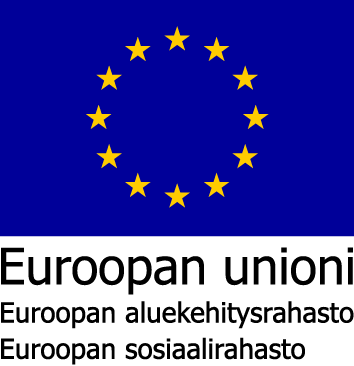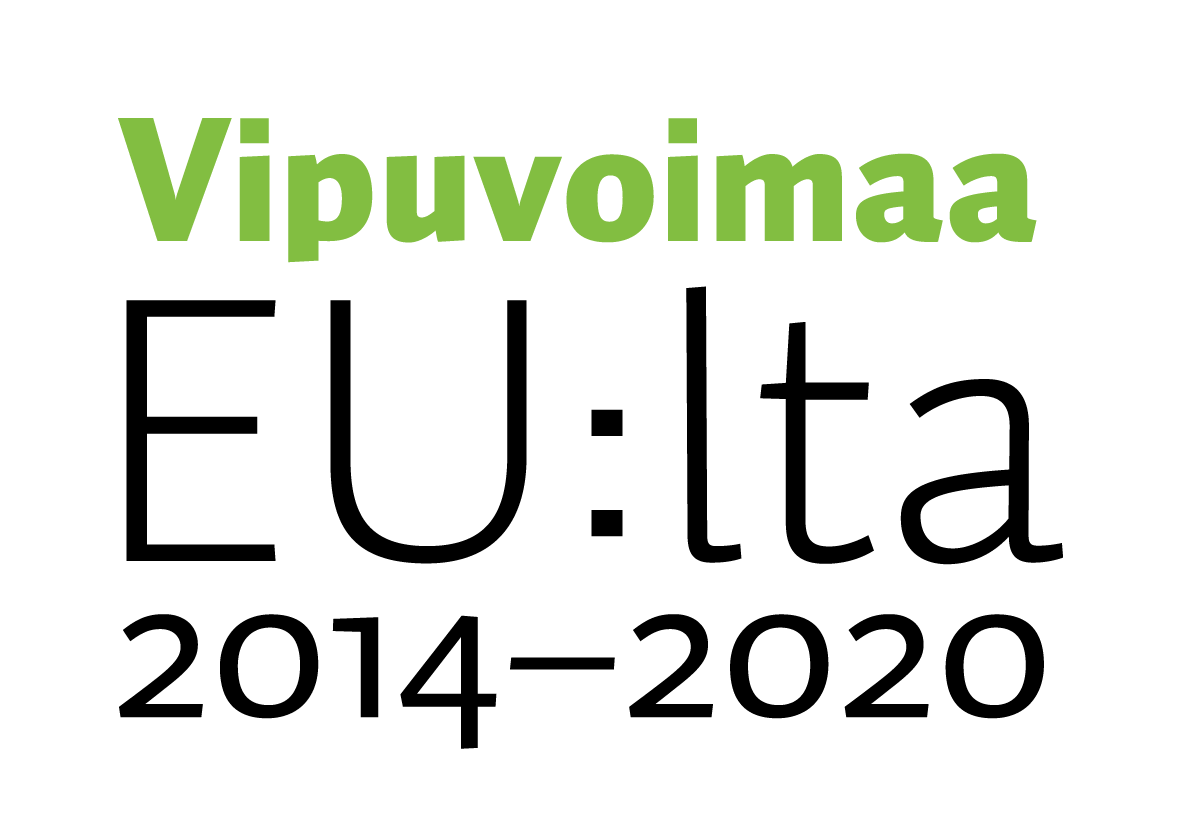

 |
 |
Hankekoodi: S21758
Hankkeen nimi: High five - Yhteistyöllä hyvinvointia Itä-Lappiin
Toimintalinja: 5. Sosiaalinen osallisuus ja köyhyyden torjunta
Erityistavoite: 10.1. Työelämän ulkopuolella olevien työ- ja toimintakyvyn parantaminen
Suunnitelman mukainen toteutusaika: Alkaa 1.9.2019 ja päättyy 31.3.2022
Toiminnan tila: Toiminta päättynyt
Vastuuviranomainen: Pohjois-Pohjanmaan elinkeino-, liikenne- ja ympäristökeskus
Hakijan virallinen nimi: Itä-Lapin kuntayhtymä
Organisaatiotyyppi: Kuntayhtymä
Y-tunnus: 1044651-6
Jakeluosoite: Kuumaniemenkatu 2A
Puhelinnumero: 0403548370
Postinumero: 98100
Postitoimipaikka: Kemijärvi
WWW-osoite: http://www.italapppi.fi
Hankkeen yhteyshenkilön nimi: Dina Terese Solatie
Yhteyshenkilön asema hakijaorganisaatiossa: kuntayhtymän johtaja
Yhteyshenkilön sähköpostisoite: dina.solatie(at)italappi.fi
Yhteyshenkilön puhelinnumero: 0403548370
Hakijoiden lukumäärä tai tuen siirto -menettely:
Hankkeen päämääränä on heikoimmassa asemassa olevien itälappilaisten hyvinvoinnin edistäminen eri toimijoiden yhteistyön vahvistamisen avulla. Hankkeen tavoitteena on olemassa olevien hyvien käytänteiden hyödyntäminen ja uusien käytänteiden kehittäminen asukkaiden hyvinvoinnin edistämiseksi, seutukunnallisen hyvinvointityön rakenteen kehittäminen Itä-Lappiin ja hyvinvointia edistävän työn tunnettavuuden lisääminen Itä-Lapin alueella.
Hankkeessa kokeillaan ja kehitetään alueen yhteistä osallisuuskoordinaattori-toimintamallia, jossa koordinaattori toimii verkostojen rakentajana, yhteistyön sparraajana ja käytännön toimenpiteiden edistäjinä kunnissa. Hankkeessa tehostetaan hyvinvointityön resurssien käyttöä, vahvistamalla olemassa olevien hyvien käytänteiden jakamista ja käyttöönottoa eri toimijoiden (kunnan eri toimialat, kolmannen sektorin toimijat, yritykset ja muut yhteistyötahot) välillä.
Hankkeessa myös pilotoidaan kuntien, järjestöjen ja asukkaiden yhteistyöhön perustuvia toimintamalleja, joilla tavoitellaan asukkaiden osallisuuden vahvistumista ja syrjäytymisen ehkäisyä (erityisesti harvaanasutulla ja pitkien välimatkojen alueella). Alueen kunnissa kokeillaan erilaisia, paikallisiin tarpeisiin vastaavia hyviä käytänteitä heikoimmassa asemassa olevien itälappilaisten hyvinvoinnin edistämiseksi. Kuntakohtaiset pilotoinnit suunnitellaan (toimintojen valinta, toteutus, aikataulu, vastuutahot, työnjako jne.) hankkeen alkuvaiheessa, alueen eri toimijoiden yhteisissä kehittämistapaamisissa, joissa työstetään yhdessä hankehenkilöstön kokoamia hyviä käytänteitä (aikaisemmat hankkeet ja muu kehittämistyö) heikoimmassa asemassa olevien asukkaiden hyvinvoinnin edistämiseksi. Osallisuuskoordinaattori tukee kuntien ja järjestöjen työntekijöitä hankkeen kohderyhmän tavoittamiseen tähtäävissä tehtävissä (kohderyhmään kuuluvien asiakkaiden tavoittaminen toimintojen pariin, eri sektoreiden toimijoiden ja verkostojen avulla), sekä on mukana kohderyhmälle järjestettävän toiminnan (yksilö- ja ryhmätoiminta, tilaisuudet ja muut matalan kynnyksen toimintamuodot) toteuttamisessa. Asukkaiden hyvinvointia edistävää työtä tehdään näkyväksi ja tunnetummaksi viestinnän avulla. Tällä tavoitellaan toimintakulttuurillista muutosta, jossa asukkaiden hyvinvointi tunnistetaan yhdeksi keskeiseksi tulevaisuuden kunnan tehtäväksi.
Hankkeen tuloksena heikoimmassa asemassa olevien itälappilaisten osallisuus- ja vaikuttamismahdollisuudet, sekä toimintakyky vahvistuvat. Hankkeessa luotua seutukunnallista hyvinvointityön rakennetta voidaan hyödyntää myös muilla alueilla. Hankkeen tuloksena hyvät käytänteet leviävät kuntien ja eri toimijoiden välillä ja uusia käytänteitä on syntynyt heikoimmassa asemassa olevien eri-ikäisten väestöryhmien hyvinvoinnin edistämiseksi ja ongelmien ennalta ehkäisemiseksi. Hankkeen tuloksena hyvinvointia edistävä työ on näkyvämpää ja tunnetumpaa Itä-Lapin alueella.
Hankkeen varsinaisena kohderyhmänä ovat heikommassa asemassa olevat itälappilaiset, joilla on erilaisia hyvinvointiin liittyviä haasteita. Esimerkiksi syrjäytymisvaarassa olevat nuoret sekä työmarkkinoiden ulkopuolella eri syistä (kuten mielenterveys- ja riippuvuusongelmat, sosiaaliset haasteet) olevat työikäiset. Erityisesti kiinnitetään huomiota väestöryhmiin, joiden ääni ei perinteisten kanavien kautta kuulu ja jotka eivät osallistu ja vaikuta olemassa olevien mahdollisuuksien kautta. Heikoimmassa asemassa olevien asemaa parantamalla halutaan vähentää eriarvoisuutta.
Kohderyhmien painotukset voivat vaihdella hankkeen aikana kunnittain. Erityisenä kohderyhmänä alkukartoituksissa nousivat esille eri kunnissa nuoret. Huolta aiheuttivat myös työttömät, joiden aktivoimiseksi oli kuitenkin alueella käynnistynyt useita hankkeita. Työttömien hyvinvoinnin edistämisen osalta keskeistä on yhteistyö ja verkostoituminen jo käynnistyneiden hankkeiden kanssa.
Hankkeen varsinaisena kohderyhmänä ovat myös Itä-Lapin alueella toimivat: kuntien eri hallinnonalojen työntekijät ja luottamushenkilöt, järjestöjen työntekijät, yrityksissä työskentelevät henkilöt, sekä muiden asukkaiden hyvinvoinnin parissa toimivien tahojen edustajat (kuten oppilaitosten edustajat). Hankkeen yhtenä tavoitteena on lisätä emt. tahojen välistä yhteistyötä ja luoda rakenteet hyvinvoinnin edistämiseksi.
Hankkeesta hyötyvät eri-ikäiset itälappilaiset, jotka eivät kuulu hankkeen varsinaiseen kohderyhmään, kuten työelämässä olevat, ikääntyneet ja niin sanotut tavalliset/hyvinvoivat lapsiperheet. Myös he hyötyvät uudenlaisista matalan kynnyksen palveluista ja toiminnoista, jotka ovat hankkeen kehittämistyön kautta helpommin saavutettavissa.
Myönnetty EU- ja valtion rahoitus: 221 952
Toteutunut EU- ja valtion rahoitus: 204 071
Suunniteltu julkinen rahoitus yhteensä: 277 440
Toteutunut julkinen rahoitus yhteensä: 259 577
Maakunnat: Lappi
Seutukunnat: Itä-Lapin
Kunnat: Savukoski, Posio, Salla, Pelkosenniemi, Kemijärvi
Jakeluosoite:
Postinumero:
Postitoimipaikka:
Suunniteltu: 6
Toteutunut seurantatietojen mukaan: 0
Suunniteltu: 78
| Välitön | Välillinen | |
| Ekologinen kestävyys | ||
| Luonnonvarojen käytön kestävyys | 1 | 1 |
| Hanke toteutetaan pääasiassa toimistotyönä. | ||
| Ilmastonmuutoksen aiheuttamien riskien vähentäminen | 0 | 0 |
| Hanke ei vaikuta ilmastonmuutoksen aiheuttamiin riskeihin. | ||
| Kasvillisuus, eliöt ja luonnon monimuotoisuus | 0 | 0 |
| Ei vaikutusta. | ||
| Pinta- ja pohjavedet, maaperä sekä ilma (ja kasvihuonekaasujen väheneminen) | 0 | 0 |
| Hanke ei heikennä pinta- ja pohjevesiä, maaperää eikä ilmaa. | ||
| Natura 2000 -ohjelman kohteet | 0 | 0 |
| Hankkeella ei ole vaikutusta Natura-alueisiin. | ||
| Taloudellinen kestävyys | ||
| Materiaalit ja jätteet | 1 | 5 |
| Hanke ei kuluta materiaaleja tai tuota merkittävästi jätettä, koska dokumentit ja tiedonvaihto hoidetaan ensisijaisesti sähköisesti. | ||
| Uusiutuvien energialähteiden käyttö | 0 | 3 |
| Hanke hyödyntää yhteiskunnan infrastruktuuria ja energiaa sen mukaan mistä kohteiden energiaa tuotetaan. | ||
| Paikallisen elinkeinorakenteen kestävä kehittäminen | 6 | 9 |
| Hankkeella on myönteinen vaikutus elinkeinorakenteeseen. Hanke edistää heikoimmassa asemassa olevien itälappilaisten hyvinvointia. | ||
| Aineettomien tuotteiden ja palvelujen kehittäminen | 5 | 7 |
| Hanke kehittää Itä-Lapin ainettomia tuottteita ja palveluita luodessaan uuden toimintamallin. | ||
| Liikkuminen ja logistiikka | 5 | 8 |
| Hankkeessa selvitetään mahdollisuuksia hyödyntää digitaalisia palveluja kohderyhmän hyvinvoinnin edistämiseksi. Esimerkkejä ovat esimerkiksi erilaiset nuorten ryhmät ja eri-ikäisten vertaisryhmät, joita voidaan toteuttaa myös sähköisesti. Hankkeen kehittämiskokouksia pidetään skypen välityksellä, mikä vähentää fyysistä liikkumista alueen kuntien välillä. | ||
| Sosiaalinen ja kulttuurinen kestävyys sekä yhdenvertaisuus | ||
| Hyvinvoinnin edistäminen | 8 | 8 |
| Hankkeen päämääränä on heikoimmassa asemassa olevien itälappilaisten hyvinvoinnin edistäminen eri toimijoiden yhteistyön vahvistamisen avulla. Hankkeessa luodaan uudenlaisia ratkaisuja (vähäiset resurssit yhdistämällä) heikoimmassa asemassa olevien väestöryhmien hyvinvoinnin edistämiseksi ja erilaisten ongelmien ennalta ehkäisemiseksi | ||
| Tasa-arvon edistäminen | 5 | 5 |
| Hankkeen toimenpiteet kohdistuvat sekä miehiin että naisiin tasa-puolisesti. | ||
| Yhteiskunnallinen ja kulttuurinen yhdenvertaisuus | 6 | 6 |
| Hankkeen toiminta perustuu heikoimmassa asemassa olevien itälappilaisten hyvinvoinnin edistämiseen ja ajatuksena on, että kaikilla asukkailla tulee olla yhdenvertaiset mahdollisuudet osallistua ja vaikuttaa, sekä esimerkiksi saada omaa hyvinvointia tukevia palveluja asuinpaikastaan riippumatta. | ||
| Kulttuuriympäristö | 3 | 3 |
| Hanke auttaa huomioimaan kulttuuriympäristön. | ||
| Ympäristöosaaminen | 0 | 0 |
| Ei vaikutusta. | ||
Hankkeessa on ollut päätavoitteina olemassa olevien hyvien käytäntöjen levittäminen sekä uusien käytänteiden kehittäminen, seutukunnallisen hyvinvointityön rakenteen kehittäminen sekä hyvinvointityön tunnettavuuden lisääminen. Asiakastyöhön ja yhteistyöhön yleensä on vaikuttanut oleellisesti hankkeen alkuvaiheessa puhjennut koronapandemia. Ei-toivottu pakote on myös opettanut hyödyntämään sähköisiä etätyökaluja, joten hankalasta tilanteesta onkin muodostonut tältä osin positiivinen asia. Heikoimmassa asemassa olevan asukkaan kohdalla tilanne on toinen. Valtakunnallisten ohjeiden mukaan moni eristäytyi ja jatkoi eristäytymistä rajoitteiden poistumisen jälkeenkin. Suuri osa kuntien työntekijöistä oli määrättynä koronatehtäviin ja hanke ei itsenäisesti pysynyt kontaktoimaan kohderyhmän ihmisiä.
Hankkeessa lähdettiin liikkeelle vuorovaikutuksen määrän kasvattamisesta kutsumalla dialogiin seutukunnan alueelta saman roolin tai tehtävän äärellä olevia henkilöitä. Tapaamiset olivat tutustumista toisten ajatteluun ja vertaisoppimista kollegiaalisessa kontekstissa. Yhteinen prosessi on näkynyt yhteydenoton kynnyksen madaltumisena, seutukunnallisen ajattelun ja keskustelun lisääntymisenä sekä seutukunnallisen hyvinvointityön ja arjen turvallisuustyön koordinoinnin tarpeen tunnistamisena.
Hyvinvointityön rakenteen osalta hanke edisti järjestöyhdyshenkilön nimeämisprosessia hankekunnissa. Itä-Lapin hyvinvointityöryhmä on pysyvä foorumi ja siksi hanke on ollut systemaattisesti yhteistyössä sen edustajien kanssa. Yhdessä toteuttiin kesän ja alkusyksyn 2021 aikana laaja hyvinvointi- ja turvallisuuskysely Kemijärvellä, Pelkosenniemellä, Posiolla ja Sallassa. Sen tulokset analysoitiin ja liitettiin osaksi sähköistä hyvinvointikertomusta.
Hyvinvointityön tunnettavuuteen on panostettu paikallislehtien mainoksilla ja artikkeleilla sekä suurella määrällä somepostauksia ja somemarkkinointia. Hyvinvointikysely on suurelta osin vaikuttanut tunnettavuuden lisääjänä. Satunnaisissa keskusteluissa kuntalaiset ovat kertoneet tunnistavansa hankkeen nimen ja hankkeen tarkoituksen.
Hyvinvointityö on kunnassa erittäin tärkeää myös jatkossa, koska jatkossa tehdyn työn toteutus ja tulokset vaikuttavat suoraa saadun valtionosuuden määrään. Määrätietoinen seutukunnallisen hyvinvointityön kehittäminen on vasta aluillaan ja siihen ollaan tämänkin hankkeen vaikutuksesta aikaisempaa valmiimpia.